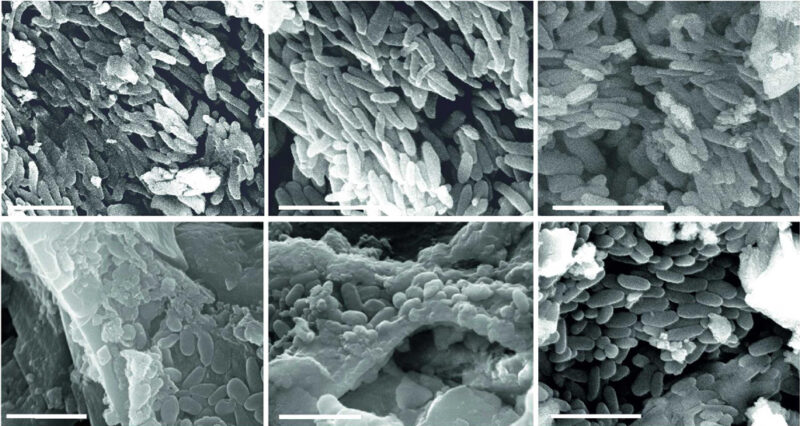Pterosaurs not only had feathers, but also were flamboyantly colorful, scientists say.
That could mean that feathers — and vibrant displays of mate-seeking plumage — may have originated as far back as the common ancestor of dinosaurs and pterosaurs, during the early Triassic Period around 250 million years ago.
Analyses of the partial skull of a 113-million-year-old pterosaur fossil revealed that the flying reptile had two types of feathers, paleontologist Aude Cincotta of University College Cork in Ireland and colleagues report April 20 in Nature. On its head, the creature, thought to be Tupandactylus imperator, had whiskerlike, single filaments and more complicated branching structures akin to those of modern bird feathers.
Because the fossil’s soft tissues were also well-preserved, the team identified a variety of different shapes of pigment-bearing melanosomes in both feathers and skin. Those shapes ranged from “very elongate cigar shapes to flattened platelike disks,” says Maria McNamara, a paleobiologist also at University College Cork.
Different melanosome shapes have been linked to different colors. Short, stubby spheroidal melanosomes are usually associated with yellow to reddish-brown colors, while the longer shapes are linked to darker colors, McNamara says.
The range of melanosome geometries found in this Tupandactylus specimen suggests that the creature may have been quite colorful, the team says. And that riot of color, in turn, hints that the feathers weren’t there just to keep the creatures warm, but may have been used for visual signaling, such as displays to attract a mate.
 Scanning electron micrographs of the soft tissues of a pterosaur’s fossilized skull reveal that different types of feathers contained different shapes of pigment-bearing melanosomes. Melanosome shapes are thought to be linked to color. In the top row, whiskerlike simple filaments contained elongated melanosomes, suggesting darker colors. In the bottom row, more complex branched feathers contained ovoid melanosomes, pointing to brighter yellows or reds. Scale bars all represent 2 micrometers.A. Cincotta et al/Nature 2022
Scanning electron micrographs of the soft tissues of a pterosaur’s fossilized skull reveal that different types of feathers contained different shapes of pigment-bearing melanosomes. Melanosome shapes are thought to be linked to color. In the top row, whiskerlike simple filaments contained elongated melanosomes, suggesting darker colors. In the bottom row, more complex branched feathers contained ovoid melanosomes, pointing to brighter yellows or reds. Scale bars all represent 2 micrometers.A. Cincotta et al/Nature 2022
Scientists have wrangled over whether pterosaurs, Earth’s first true vertebrate flyers, had true feathers, or whether their bodies were covered in something more primitive and hairlike, dubbed “pycnofibers” (SN: 7/22/21). If the flying reptiles did have feathers, they weren’t needed for flying; pterosaurs had fibrous membranes stretched between their long, tapering wings, much like modern bats (SN: 10/22/20).
In 2018, a team of researchers including McNamara reported that some of the fuzz covering two fossilized pterosaur specimens wasn’t just simple pycnofibers but showed distinct, complex, branching patterns similar to those seen in modern feathers (SN: 12/21/18). But some researchers have disputed this, saying that the branching observed in the fossils was an artifact of preservation, the appearance of branching created by overlapping fibers.
The new pterosaur specimen has “turned all that on its head,” McNamara says. In this fossil, “it’s very clear. We see feathers that are separated, isolated — you can’t say it’s an overlap of structures.” The fossilized feathers show successive branches of consistent length, extending all the way along a feather’s shaft.
And though the previous pterosaur fossils described in 2018 did have some preserved melanosomes, those were “middle-of-the-road shapes, little short ovoids,” McNamara says. In Tupandactylus, “for the first time we see melanosomes of different geometries” in the feathers. That all adds up to bright, colorful plumage.
“To me, these fossils close the case. Pterosaurs really had feathers,” says Stephen Brusatte, a vertebrate paleontologist at the University of Edinburgh who was not involved in the study. “Not only were many famous dinosaurs actually big fluffballs,” he says, but so were many pterosaurs.

Sign Up For the Latest from Science News
Headlines and summaries of the latest Science News articles, delivered to your inbox
Client key* E-mail Address* Go
Thank you for signing up!
There was a problem signing you up.
Many dinosaurs, particularly theropod dinosaurs, also had colorful feathers (SN: 7/24/14). What this study shows is that feathers aren’t merely a bird thing, or even just a dinosaur thing, but that feathers evolved even deeper in time, Brusatte adds. And, as pterosaurs had wing membranes for flying, their feathers must have served other purposes, such as for insulation and communication.
It’s possible that dinosaurs and pterosaurs evolved this colorful plumage independently, McNamara says. But the shared structural complexity of the pigments in both groups of reptiles makes it “much more likely that it was derived from a common ancestor in the early Triassic.”
“That’s a big new implication,” says Michael Benton, a paleontologist at the University of Bristol in England.
Benton, a coauthor on the 2018 paper, wrote a separate commentary on the new study in the same issue of Nature. If feathers arose in a common ancestor, Benton says, that would push back the origin of feathers by about 100 million years, to roughly 250 million years ago.
And that might have other interesting implications, Benton writes. The early Triassic was a rough time for life on Earth; it was the aftermath of the mass extinction at the end of the Permian that killed off more than 90 percent of the planet’s species (SN: 12/6/18). If feathers did evolve during that time, the insulating fuzz, as well as warm-bloodedness, may have been part of an early arms race between reptilian mammal ancestors called synapsids and the pterosaur-dinosaur ancestor.

